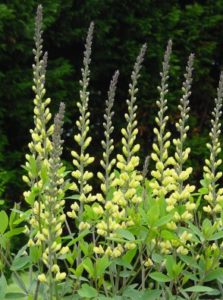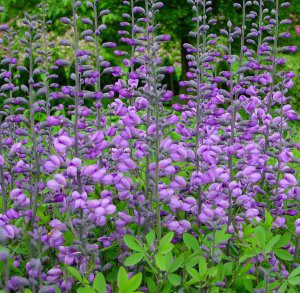Wild indigos or Baptisias (Baptisia spp.) are long-lived native perennials. Baptisias are tap rooted perennials that will reward you for many years. They’re sometimes mistaken for Carolina lupine (Thermopsis caroliniana).
Modern day cultivars are hybrids of 4 Baptisia species: purple (B. australis), lavender blue (B. minor), white (B. alba), bright yellow (B. sphaerocarpa). Several bicolors are also available. Baptisias bloom for 3 to 4 weeks. Their blue-gray foliage and sturdy upright shrubby habit are pluses in the summer garden.
Baptisias perform at their best in full sun. In the shade they bloom less and stems are weak and frequently require staking. Baptisias prefer a deep humus-rich well-drained soil, but tolerate average soil. Mulch with organic matter to keep the soil cool and weed-free.
Vigorous plants grow 3 to 4 feet high and 4 to 5 feet wide after 3 to 5 years. Do not overcrowd. Newly planted baptisias should be watered until established, usually within 1-2 year. Plants are slow to establish and begin blooming, usually a few flowers in their first year and are covered with flowers in 3 to 4 years.
In early spring add 1-2 handfuls of a slow-release fertilizer around plants. Older well established plants require little to no fertilizer as they produce their own nitrogen. Yellowing of leaves in the summer is a symptom of iron deficiency or high soil pH. In such cases, feed with chelated iron or a water-soluble fertilizer such as Schultz™ or Miracid™. Established plants are heat and drought tolerant and are almost invincible to disease and insect problems.
Stunning stalks of colorful pea-like flowers appear in mid-spring. Flowers stalks give way to black seedpods by late July. Gardeners may opt to remove the seed pods before they mature. Flower arrangers utilize the ripe blacken seedpods in arrangements.
Cultivars with the deeper shades of blue and yellow blooms stand out in a garden. Popular cultivars include: ‘Purple Smoke’ (lavender flowers), ‘Solar Flare’ (yellow), ‘Alba’ (white), and ‘Twilight Prairie Blues’.



 Posted in
Posted in 
